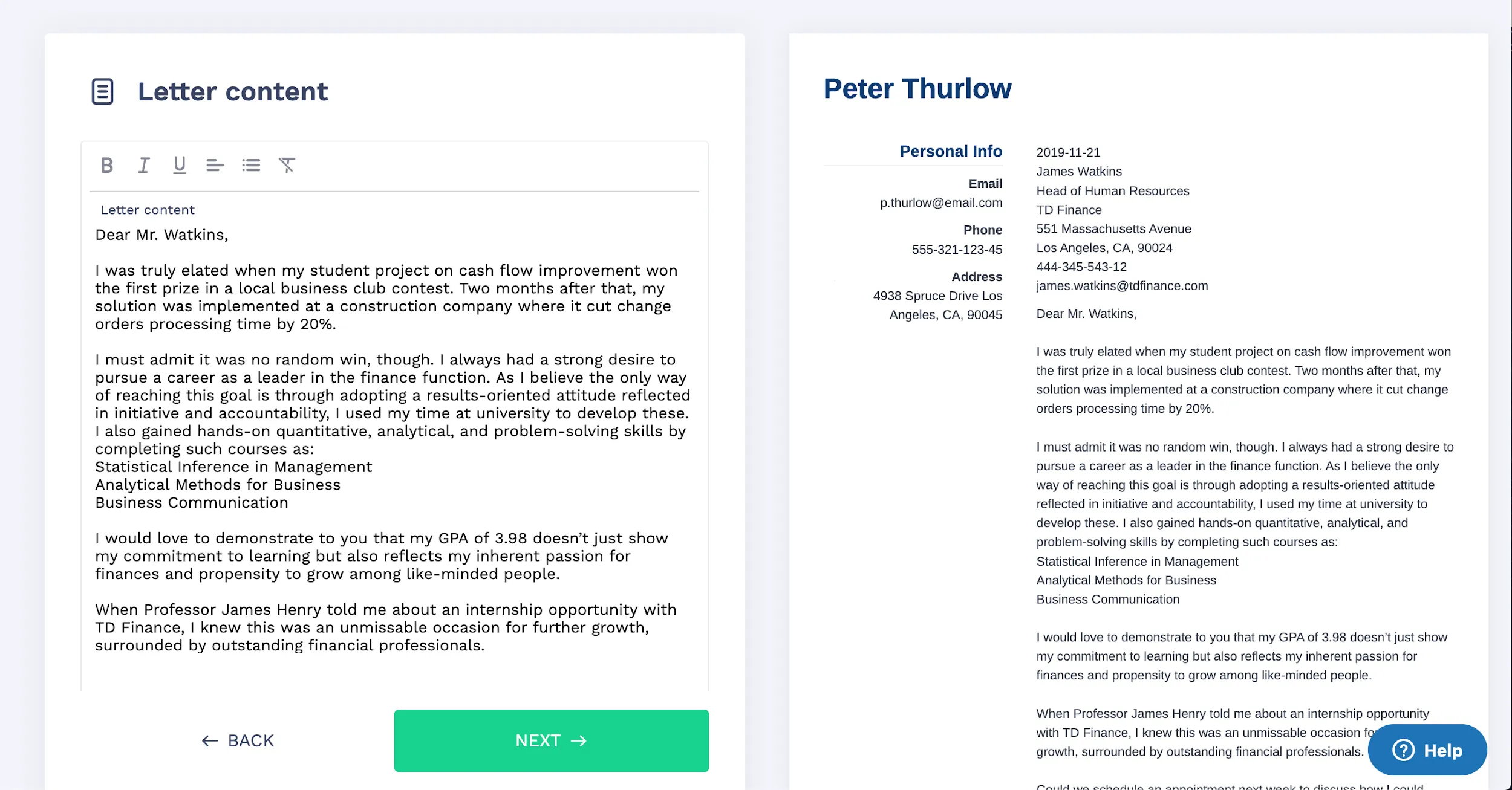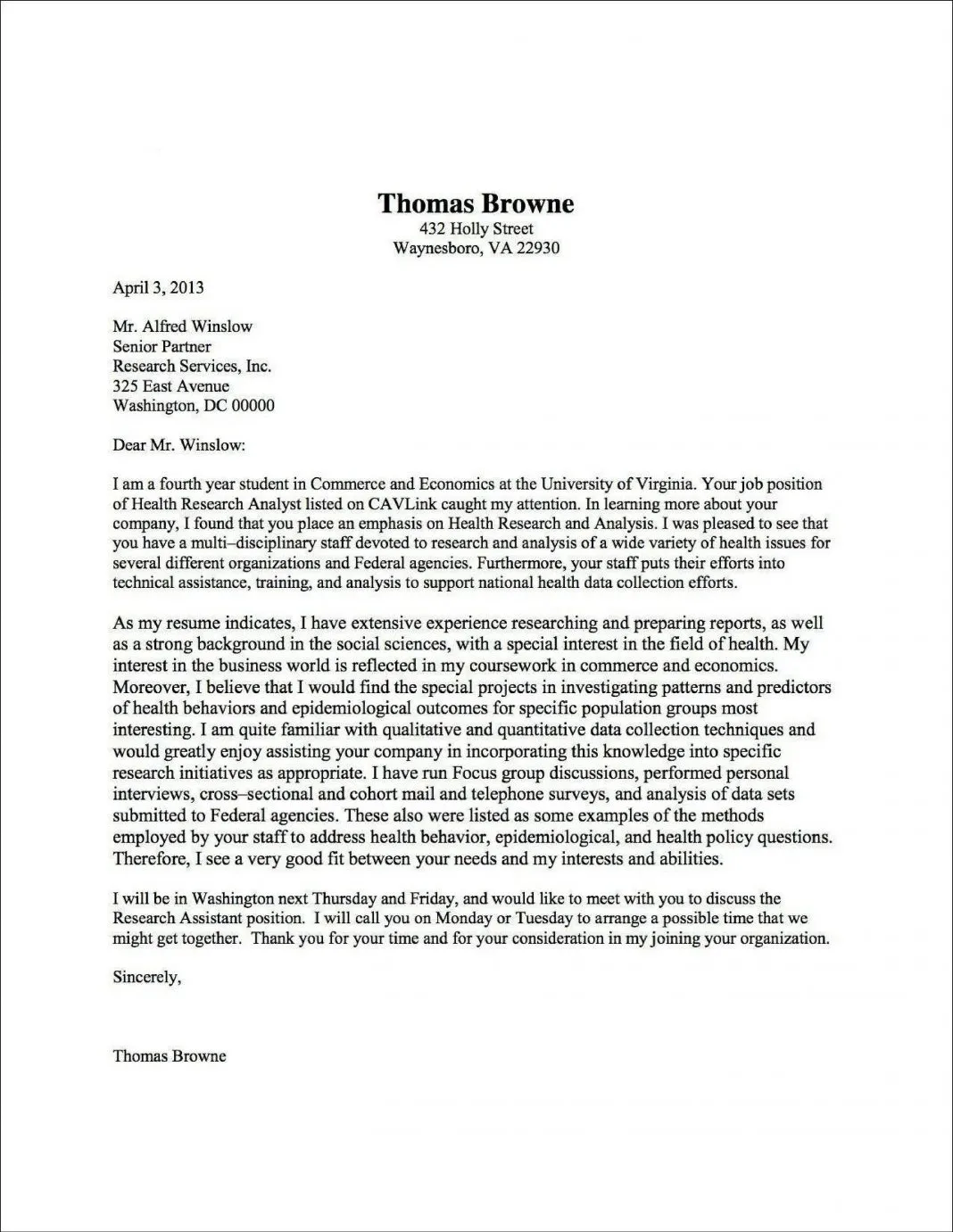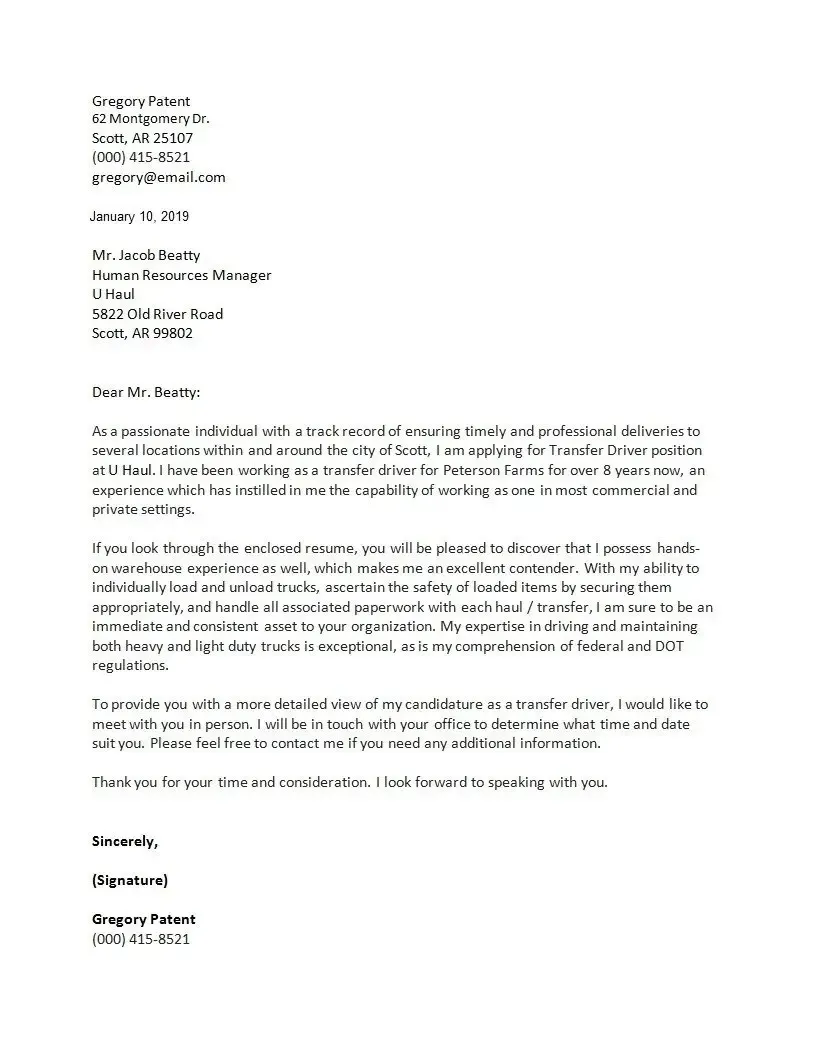Why You Need a Cover Letter
In today’s competitive job market, a compelling cover letter is more than just a formality; it’s your opportunity to make a strong first impression and distinguish yourself from other applicants. A well-crafted cover letter complements your resume by providing context, showcasing your personality, and demonstrating your genuine interest in the role and the company. It allows you to elaborate on your skills, experiences, and achievements, which might not be fully captured in a resume. Recruiters often use cover letters to assess your communication skills, writing style, and ability to articulate your value proposition. Without a cover letter, you risk appearing generic and less enthusiastic, potentially missing out on opportunities to secure an interview. Furthermore, a cover letter shows that you have taken the time to understand the specific job requirements and tailor your application accordingly, indicating that you are a serious candidate. Therefore, a cover letter is a crucial tool in your job-seeking arsenal, helping you stand out and increase your chances of landing your dream job.
What to Include in Your Cover Letter
A successful cover letter includes several key components that collectively present you as an ideal candidate. Start with your contact information and the date, followed by the hiring manager’s details. The opening paragraph should grab the reader’s attention, clearly stating the position you are applying for and expressing your enthusiasm. The middle paragraphs should highlight your relevant skills and experience, providing specific examples and quantifying your achievements whenever possible. This is the section where you connect your qualifications with the job requirements, emphasizing how your skills align with the company’s needs. The closing paragraph should reiterate your interest, summarize your key qualifications, and include a clear call to action, such as requesting an interview. Be sure to proofread your cover letter meticulously, paying attention to grammar, spelling, and clarity. Tailor your cover letter to each job application, ensuring that the content is relevant and targeted to the specific requirements outlined in the job description. Remember, a well-structured and personalized cover letter can significantly increase your chances of getting noticed and securing an interview.
Your Contact Information and Date

Begin your cover letter by providing your contact information, which should be at the top of the document. Include your full name, address, phone number, and professional email address. Ensure that your email address sounds professional. Following this, include the date on which you are writing the cover letter. This information ensures that the hiring manager can easily contact you and also shows that you have prepared a recent application. Properly formatting your contact details and date sets a professional tone from the start, demonstrating your attention to detail and organizational skills. Use a clear and readable font and layout to ensure your information is easy to find. Double-check all details to avoid errors, as even minor mistakes can impact the first impression you make on the hiring manager. A well-organized contact section sets the stage for the rest of your cover letter, making it easy for the hiring manager to reach out if they are interested in your profile.
Hiring Manager’s Information
Next, include the hiring manager’s information, usually on the left side of the letter, directly below your contact details and the date. Start with the hiring manager’s name (if available), their title, the company name, and the company’s address. Addressing your cover letter to a specific person is more personal and shows that you have taken the time to research the company. If you cannot find the name of the hiring manager, you can use a general salutation, such as “Dear Hiring Manager” or “Dear [Department Name] Hiring Team.” Researching the hiring manager can be a challenge, but it shows initiative and can potentially set you apart from other applicants. If you find the hiring manager’s name, ensure that you spell it correctly. This level of detail demonstrates your attention to detail and respect for the recipient, thereby creating a better first impression. This step is critical in the process of cover letter writing.
Opening Paragraph: Grab Attention
The opening paragraph is your first opportunity to captivate the hiring manager’s attention and set the tone for the rest of your cover letter. Begin by clearly stating the position you are applying for and where you found the job posting. This helps the hiring manager quickly understand the purpose of your letter. Then, use this section to express your enthusiasm for the role and the company. Consider starting with a compelling statement that captures your interest, such as mentioning a company achievement you admire or a specific project that aligns with your skills. Briefly highlight one or two of your most relevant skills or experiences, creating an initial connection to the job requirements. Your goal is to convince the hiring manager to keep reading, therefore, the opening should be concise, engaging, and tailored to the specific job. A well-crafted opening paragraph immediately signals that you are a serious candidate and have taken the time to research the company and role. Be sure to avoid generic phrases and focus on conveying genuine interest.
Middle Paragraphs: Show Your Value

The middle paragraphs are where you showcase your skills, experience, and achievements, demonstrating how they align with the job requirements. Focus on the specific requirements listed in the job description, and provide concrete examples that illustrate your capabilities. Use the STAR method (Situation, Task, Action, Result) to describe your experiences, providing context, outlining the challenges you faced, and explaining your actions and the outcomes you achieved. Quantify your achievements whenever possible, using numbers, percentages, or specific data points to demonstrate your impact. Tailor these paragraphs to the job, highlighting experiences and skills that are most relevant to the position. By providing detailed examples, you not only show that you possess the necessary skills but also that you can apply them effectively in a professional environment. This is where you show your value, making a case for why you are the perfect fit for the role. It’s crucial that you show, not just tell, the hiring manager.
Highlight Relevant Skills and Experience
When highlighting your skills and experience, focus on those that directly align with the job requirements. Review the job description carefully and identify the key skills and qualifications the employer is seeking. Then, select examples from your past experiences that demonstrate these skills. Use specific keywords from the job description to show that you understand the position and the company’s needs. Provide concrete examples of how you used these skills in past roles, what projects you worked on, and the results you achieved. Consider incorporating a mix of hard skills (technical abilities) and soft skills (interpersonal and communication abilities) to create a well-rounded profile. Keep the language clear, concise, and easy to understand. Aim for a balance between showcasing your skills and experience without overwhelming the hiring manager with excessive detail. Prioritize the most important skills and experiences that directly relate to the role you are applying for, and ensure they are presented in a way that makes you stand out.
Quantify Your Achievements
Quantifying your achievements adds significant weight to your cover letter, making your accomplishments more tangible and impressive. Instead of simply stating that you improved a process, specify by how much, such as “Reduced processing time by 15%.” Use numbers, percentages, and specific data points to demonstrate your impact and the value you brought to previous roles. For example, if you increased sales, mention the percentage increase or the total revenue generated. If you saved the company money, specify the amount. If you improved customer satisfaction, include the percentage. Provide context for your achievements, explaining the challenges you faced and how you overcame them. This helps the hiring manager understand the significance of your accomplishments. This data-driven approach makes your claims more credible and highlights your ability to deliver results. Using quantifiable results underscores your ability to make a tangible difference in the role. These achievements show your value and are a critical part of cover letters.
Closing Paragraph: Call to Action

The closing paragraph is your final opportunity to leave a lasting impression and encourage the hiring manager to take action. Reiterate your enthusiasm for the position and summarize your key qualifications. Express your confidence that you possess the skills and experience required to excel in the role. Include a clear call to action, such as requesting an interview. Specify your availability for an interview, if applicable. Thank the hiring manager for their time and consideration. This demonstrates your professionalism and respect. Ensure the tone of your closing is confident yet polite, and avoid sounding overly demanding. A well-crafted closing paragraph reinforces your interest in the position, reinforces your value proposition, and provides a clear direction for the hiring manager to move forward. It should leave a positive impression, ensuring the hiring manager remembers you and is encouraged to reach out. The closing must leave a lasting impression.
Proofread and Edit Your Cover Letter
Before submitting your cover letter, it is essential to proofread and edit it meticulously. Typos, grammatical errors, and formatting inconsistencies can undermine your credibility and professionalism, potentially leading to your application being overlooked. Start by checking for any spelling and grammatical errors using a spell checker and grammar checker. However, do not rely solely on these tools, as they can sometimes miss errors. Read your cover letter aloud to catch awkward phrasing and ensure that the text flows smoothly. Consider having someone else proofread your cover letter; a fresh pair of eyes can often catch mistakes that you might have missed. Pay close attention to the tone and ensure it is appropriate for the role and company. Ensure that your formatting is consistent throughout the document, with clear headings, spacing, and font choices. Proofreading and editing is a critical step in the process of crafting a compelling cover letter, ensuring that your message is clear, professional, and error-free.
Formatting Your Cover Letter for Success
Effective formatting is crucial for making your cover letter easy to read and visually appealing. Use standard business letter format, including your contact information, the date, the hiring manager’s information, and a professional salutation. Choose a professional and readable font, such as Times New Roman, Arial, or Calibri, and maintain a consistent font size. Use a font size between 10 and 12 points. Maintain a consistent spacing throughout the document, typically single-spaced with a double space between paragraphs. Use clear headings and subheadings to break up the text and make it easier to scan. Use bullet points to highlight key skills or accomplishments. Ensure your letter fits on one page, as hiring managers often have limited time to review each application. Avoid using excessive formatting or decorative elements, as they can distract from the content. Use a professional and easy-to-read format and ensure that the cover letter is easy to read and visually appealing.
Choosing the Right Font and Font Size

Choosing the right font and font size is an important part of formatting your cover letter for readability and professionalism. Opt for a standard, professional font such as Times New Roman, Arial, Calibri, or Helvetica. These fonts are widely recognized and easy on the eyes, making your cover letter accessible to all readers. Avoid using overly stylized or decorative fonts, as they can appear unprofessional and distracting. Select a font size between 10 and 12 points to ensure your text is legible without appearing cramped or oversized. A font size of 11 or 12 is usually recommended for cover letters. Maintain a consistent font size throughout the entire document for a polished look. Double-check that the chosen font is compatible with the software you are using and that it will render correctly on the recipient’s computer. A clear and professional font enhances the readability of your cover letter, ensuring that the hiring manager can easily absorb the information you are presenting. This shows attention to detail.
How to Tailor Your Cover Letter
Tailoring your cover letter to each job application is essential for demonstrating your genuine interest and making a strong impression. Review the job description carefully, identifying the specific skills, experiences, and qualifications that the employer is seeking. Use keywords from the job description throughout your cover letter to show that you understand the role and that your skills are a good match. Customize your opening paragraph to express your enthusiasm for the specific position and the company. Highlight the experiences and achievements that are most relevant to the job, providing concrete examples and quantifying your results whenever possible. Avoid using a generic cover letter template and instead personalize each letter to reflect the requirements of the specific role. Research the company to understand its values, mission, and recent achievements. Reference this information in your cover letter to demonstrate your interest and show you understand the company. Tailoring your cover letter significantly increases your chances of getting noticed and securing an interview, because it shows you care and understand what the role demands.
Cover Letter Examples and Templates
Using cover letter examples and templates can be a helpful starting point for crafting your own cover letter, but always ensure that you personalize them to fit your specific situation. Numerous resources provide templates for various industries and job types. These templates can help you understand the structure, format, and language commonly used in cover letters. Adapt the content to reflect your skills, experience, and the requirements of the job you are applying for. Use examples as inspiration but avoid simply copying and pasting. Tailor the content, wording, and tone to suit your individual profile and the specific job. Review multiple examples to gain a comprehensive understanding of different approaches and writing styles. However, remember that the most effective cover letter is one that is uniquely yours, reflecting your personality, skills, and genuine interest in the role. Customize the templates to reflect you.
